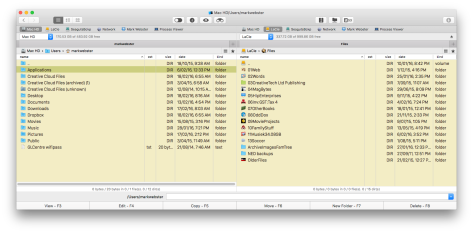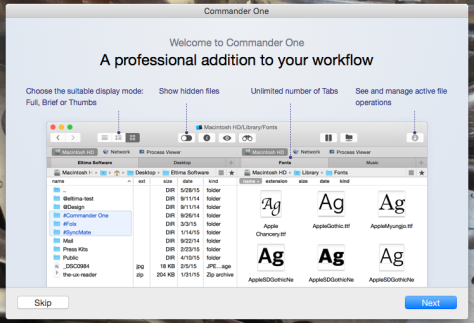Computer sales are falling everywhere – except for Apple. Apple’s Mac sales are going up. So while people are ditching their PCs, they’re buying Macs in seemingly ever-increasing numbers.
We in the Apple world have always called these people ‘Switchers’, and although I’ve never used a PC except in the library, I’ve had to learn a few PC-like things just so I know what to point out to those people who are changing to Mac and are feeling a little lost.
Therefore, in some ways I was not well qualified to talk about Commander One, since I didn’t really know what ‘dual-pane file managers’ were and why Windows users like them so much.
Now I understand! Commander One is an attempt to bring that dual pane file management to Mac users, and it adds many power-user features while it does so.
Eltima Software is a German development company that specialised in Windows apps to enable sharing of devices, over various types of networks (Ethernet, USB …) but I guess the company is seeing the writing on the wall (ever increasing numbers of switchers) to the point that it has had developers schooled in Apple’s new developer language Swift: that was used entirely to code Commander One.
And already Eltima’s product listing of Mac apps is impressive: SyncMate, Elmedia Player (which is a more fully featured QuickTime-like player that even lsts you download YouTube clips), Folx, PhotoBulk, Airy, Swordbox, SyncMate 4, Recover PDF Password, USB Network Gate, Typeeto, Flexihub, Unclouder, Flash Decompiler Trillix, Flash Optimizer and of course Commander One.
So, what is it? Commander One has a main window is split into side-by-side panes that can be used to act upon files and folders in multiple locations at once. The free version works with local and network drives and supports search, preview and the ability to rename files during copy and move, which you cannot do with Finder. The paid upgrade to Pro adds power user features including a process viewer with one-button access (sure, every Mac can do this via Activity Monitor, which is already in your Utilities folder in Applications), archive compression and extraction, a built-in FTP manager, and direct access to Dropbox accounts, MTP, or even iOS devices (if they’re connected by cable).
The most obvious use is simply copying files from one hard drive/thumb drive/whatever to another pane-to-pane. Of course, you can do this in Finder but you have to have two folders open, or open in tabs in one window, or drag-and-drop from one onto another and wait for that somewhat off-putting springload feature to open that, and then perhaps several others in turn, which can be tedious, not to mention confusing when you let go at the wrong instant.
Buttons along the top could do with a little work. The binoculars icon for search … why not just a magnifying glass with is normal for almost everything else? And QuickLook doesn’t work with the spacebar-tap to launch full-resolution file previews: you have to actually click the QuickLook icon. Why? Ah, because the spacebar is used to arbitrarily select files for a mass operation.
Bells and whistles — Basically, Commander One is a graphic user interface on the Unix commands that the real pros use in favour of the Finder. The result is a Finder addition rather than a replacement – Finder has a file picker in Open and Save As dialog boxes; Command One does not. The box that opens when you mount a disk image or another volume is also not a C1 feature.
But with Commander, you can execute a mass file-rename when you move files, which administrators and IT people will appreciate. You can queue large, disk-intensive operations for delayed execution to queue up copies and backups. You can even use regular expressions for file selection. You can quickly turn hidden files on and off with just a button in the top toolbar (not that easy, otherwise) and copy file paths. You can also use its built-in compression support (zip, plus rar, tgz, 7z and more in the Pro version), view hex and binary files, it has a robust network browser for finding files on connected volumes, there’s root access, you can customise hotkeys for quick launches of your most-used features, and it has a history tool.
Which version? The free version gives you the File Viewer, lists computers on your network, Root access, customisable hotkeys, fonts and colours, Brief mode and History and favourites. It also has Zip support for file compression.
The Pro version adds access to your Dropbox, Google Drive and Amazon S3 accounts, the ability to mount devices (ie, hard drives and USB drives plus cameras and camera cards), compression and extraction, a Terminal emulator, themes, process manager and an FTP manager.
What’s great — Easier copying from one volume to another is the most obvious feature any user can appreciate. The free version has most features – Pro only adds a few extras and these tend to be esoteric. Routine file tasks including View, Edit, Copy, Move, and Delete are displayed across the bottom of the window, attached to F-keys (Delete = F8, for example).
What’s not — The interface can be a bit confusing and it’s not the most attractive, but being able to change the theme (in the Pro version) in Preferences or just some of the colours (free) helps, and there are three View modes (Full, Brief and Icons). I wish spacebar just launched previews. Some users have reported permissions errors with some more deeply protected files, and flaky handling of FTP.
Needs — Mac users who regularly move files around. Commander One makes it so much easier.
What — Commander One by Eltima Software, free and [http://mac.eltima.com/commander-one-purchase.html] US$29.95 personal, US$99.95 for five users and US$299.95 Company license (up to 50 Macs). Support options are US$15 a year (Urgent) and a Lifetime Guarantee option for $29.95.
System — OS X 10.9 or greater, 16.9Mb free space
Contact — Eltima Software (also in the Mac App Store)


